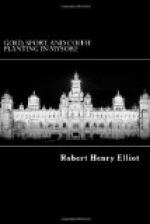The falls of Gairsoppa are on the Sarawati, or Arrowborn[6] river, which, rising in the western woodland region of Northern Mysore, flows north-west for about sixty-two miles, and then, turning abruptly to the west, precipitates its waters over cliffs about 860 feet in height. When the river is at the full in the south-west monsoon an immense body of water rushes over the precipice, and from calculations made by some engineers, and which are recorded in the book at the Travellers’ Bungalow, the volume and height of fall at that time, if taken together, would give a force of water about equal to that of Niagara. But, however that may be, a glance at the high water marks, and a knowledge of the immense rainfall on the crests of the Ghauts during the monsoon months, makes it certain that, at that time of year, the amount of water must be very large. At that season, though, the falls are almost invisible, as they are concealed by vast masses of mist and spray, and even were they visible, as the water then stretches from bank to bank, there would only be one vast monotonous fall. But after the heavy monsoon floods are over, the river above the falls-shrinks back as it were into a long deep pool which lies at a distance of several hundred yards from the brink of the precipice, and from this pool the water of the river then escapes by four distinct rapids which have cut their way to-the brink of the precipice, and fall over the cliffs in four distinct falls, each one of widely different character from the others. The falls at this season are only 834 feet high, but when the river rises to the full the fall, as I before mentioned, must be about 860 feet, or approximating in height to the loftiest story of the Eiffel Tower. Across the rapids light bridges of bamboo are thrown, at the end of each monsoon. There are thus two ways of crossing the river—one by the pool above the falls where there is a ferry-boat which can take over horses as well as people—the other by the bridges of the rapids—and it is necessary to cross the river because the only bungalow is on the north, or Bombay side of the river, and the best point for seeing the falls is on the southern side. The only way too of reaching the bottom of the falls is by the southern side.
The only objection to these falls is the difficulty of getting at them, owing to their being quite out of the usual travellers’ route, and that is why they have, if I may judge by the travellers’ book at the bungalow,[7] been, comparatively speaking, rarely visited. Then there is no railway nearer than about ninety miles, and though the falls are only thirty-five miles from the western coast, steamers do not call at the nearest port to them. Nor is it at all even probable that any line will ever be brought nearer to the falls than about sixty miles. It is, too, rather discouraging to have the prospect of a ninety mile road journey to see the falls, and then return by the same route. But I would suggest




